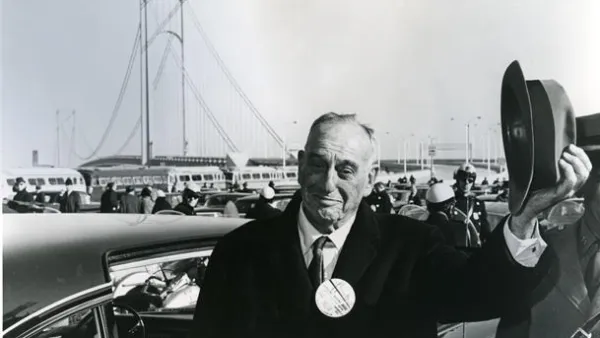Anthony Flint examines the commonalities—and disparities—in the historic legacies of Frederick Law Olmsted and Robert Moses.
For two of the most prominent figures in the history of American planning, the legacies of Frederick Law Olmsted and Robert Moses could not be much more different, yet the two had much in common. According to an article by Anthony Flint: "They both were top-down, hard-charging master planners, creatures of authorities and commissions that helped them get things done. Both perturbed by the jarring cacophony of the city, they sought the best for the American people, and produced glorious public recreation facilities known the world over. They both had a fondness for poetry, and both were accepted at Yale."
Flint's argument, however, is that Moses's strengths were traits he shared with Olmsted: "Olmsted built beautiful parkways, too, and undeniably looked at public works and city-building at a grand scale. His firm’s blueprints were wonderfully regional. He thought comprehensively, encompassing public health benefits, sanitation, circulation, and increases in property values. And he was every bit as dogged, in his own way, as Moses, willing to get his hands dirty, immersing in necessary politics, and practicing wait-them-out patience with great skill. As I’ve said myself about Moses, those are qualities we need today—a regional vision, the skill to align bureaucracies—as coastal cities attempt to build resilience and prepare for the inevitable impacts of climate change."
Moreover, although it's still common to vilify Moses as a symbol of top-down planning, to completely disregard his skill and accomplishments is still likely dangerous: "The warning is clear: the rest of the world shouldn’t fall into the same old trap and practice the top-down planning that Jacobs rebelled against a half-century ago. But it would be a shame if Moses’s excesses have permanently given large-scale planning a bad name, even as conditions on the ground warrant a more regional vision."
FULL STORY: Olmsted the Hero, Moses the Villain

Analysis: Cybertruck Fatality Rate Far Exceeds That of Ford Pinto
The Tesla Cybertruck was recalled seven times last year.

National Parks Layoffs Will Cause Communities to Lose Billions
Thousands of essential park workers were laid off this week, just before the busy spring break season.

Retro-silient?: America’s First “Eco-burb,” The Woodlands Turns 50
A master-planned community north of Houston offers lessons on green infrastructure and resilient design, but falls short of its founder’s lofty affordability and walkability goals.

Test News Post 1
This is a summary

Analysis: Cybertruck Fatality Rate Far Exceeds That of Ford Pinto
The Tesla Cybertruck was recalled seven times last year.

Test News Headline 46
Test for the image on the front page.
Urban Design for Planners 1: Software Tools
This six-course series explores essential urban design concepts using open source software and equips planners with the tools they need to participate fully in the urban design process.
Planning for Universal Design
Learn the tools for implementing Universal Design in planning regulations.
EMC Planning Group, Inc.
Planetizen
Planetizen
Mpact (formerly Rail~Volution)
Great Falls Development Authority, Inc.
HUDs Office of Policy Development and Research
NYU Wagner Graduate School of Public Service




























